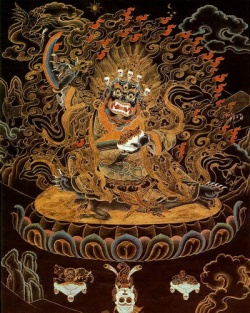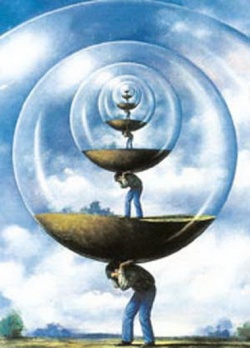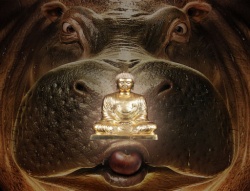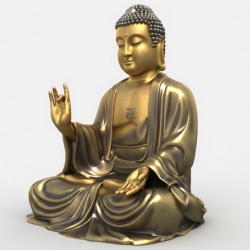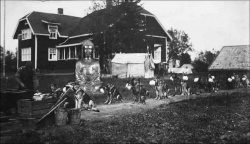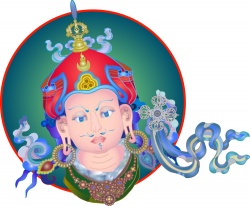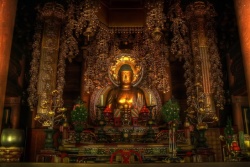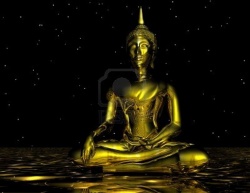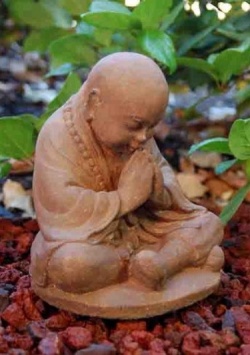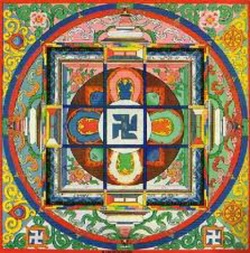Religious Music : Buddhism -- Buddhist Ritual Performing Arts
Religious Music : Buddhism
Buddhist Ritual Performing Arts
Byong Won Lee
Introduction
Korea’s material and spiritual culture has been deeply rooted in Buddhism since its introduction to the country in the late fourth century CE Through-out Korea’s historical kingdoms the major role of Buddhism has been as an educational and protective medium. In the early stages of its propagation, the religion was mainly supported by aristocrats. However, first through gradual assimilation with the indigenous shamanism, and then with Confucianism, even those who professed no religion at all became Buddhist, even if only unconsciously. Presently, the population of Buddhist worshippers is approximately 12 million in South Korea. The Buddhist attitude toward life and sense of values unconsciously permeated deeply into the lives of Koreans.
As Mahayana, the principal sect of Korean Buddhism, became integrated into the people’s daily lives, the practice of its ritual performing arts became thoroughly institutionalized. Buddhist ritual performing arts played a vital role in intensifying religious experiences in the various Buddhist rites. Despite certain shared features with the Buddhism of China and Japan, in form and substance, the Buddhist rituals performed in Korea are closer to those of Tibet than to those of its neighbor countries.
The three practices that are most conspicuous in their similarity to those of the Tibetan Lamaist rituals ─ but different from those of China and Japan ─ are the use of the outdoor band (chwita), ritual dances (jakbeop), flexibility in duration of certain chants, and the occasional insertion of a series of non-lexical syllables in chant texts.
Historical Development of the Buddhist Ritual Performing Arts
1) The Three Kingdoms and the Unified Silla
Korean Buddhism was imported from China in the late fourth century during the so-called Three Kingdoms period of Goguryeo (37 BCE - 668 CE), Baekje (18 BCE - 660 CE), and Silla (57 BCE - 935 CE). Buddhism came first to Goguryeo in 372, then to Beakje in 384, and finally to Silla, which proclaimed Buddhism as the officially favored religion in 528.
The historical sources of the Goguryeo and Baekje kingdoms do not provide detailed descriptions of their respective Buddhist performing arts. However, they show that Baekje played a vital role in the transmission of Buddhism and Chinese culture to Japan. In 522 the Baekje court sent a number of volumes of sutras and other Buddhist items to Japan. Mimaji (Mimashi in Japanese) emigrated from Baekje to Japan in 612 and taught giak (Japanese gigaku), a masked pantomime which he had learned in southern China. In Korea, remnants of the maskdance- drama may be found in talchum (mask dance). Both Japanese gigaku and Korean talchum ─ an extant remnant of the mask-dance-drama ─ employ Buddhist stories.
Largely because of its solidly-established native religion, Silla was the last to adopt Buddhism. Nevertheless, once Silla opened the door to foreign culture in the latter part of the seventh century, its importation and adoption of the highly developed Buddhism of China’s Tang Dynasty (618-907) was accelerated. Abundant historical remains in Gyeongju, which was the capital of Silla, display the culmination of Silla’s Buddhist culture. More Buddhist musical assets from the Silla kingdom survive than those from the Goguryeo or Baekje, and from the Silla remains we know that elaborate, kingdom-wide Buddhist rites flourished in temples with encouragement from the court. A representation of instrumental music performance and dancing carved on a pagoda in a temple located in Jeollado Province, in southwestern Korea dates from the three kingdoms period. This three-storied, Four-Lion Pagoda of Hwaeomsa Temple, originally built in 544 and reconstructed during the reign of King Sukjong (1674- 1720) of the Joseon Dynasty (1392-1910), is located in the isolated Heights of Filial Piety on the temple site. In carvings around its foundation, Apsaras are portrayed as dancing, singing, and playing a transverse flute, an hourglass drum, and a lute. A similar performance is portrayed on a stone lantern in Todaiji Temple in Japan, constructed in 729, and in pre-Sung Dynasty (960-1279) Chinese mural paintings preserved in the Dunhuang Caves.
These iconographic sources apparently illustrate an early Indian influence that came to Korea and Japan indirectly through China. In India, an ensemble consisting of wind and string instruments accompanied the performance of stotra, the predecessor of East Asian Buddhist hymns. Such carvings or paintings of instrumental performance became obsolete in East Asia after the fall of the Chinese Tang Dynasty in 907. None of the instruments found in these artifacts are used in today’s Korean or Chinese rites, and, in Japan, until recently, instrumental accompaniment was employed for bombai chanting only in the Higashi Honganji branch of the Buddhist Otani School.
Approximately two centuries after the construction of Hwaeomsa Temple, priest Weolmyeong stated that in 760 he only knew hyangga (native songs) and was not familiar with Buddhist chant. Hyangga is a chanted poetic form which appeared sometime after the unification of the Korean peninsula by the Silla Kingdom in 668. In contrast to earlier genres that were transmitted orally, hyangga were written in Chinese characters, then the only means of writing in Korea. They were mostly written and chanted by Buddhist priests, men of the highest cultural class, at Buddhist festivities. This may indicate that, during Unified Silla, Buddhist chant was sung only by a certain class of priests who specialized in it. Although hyangga did not function strictly as Buddhist chant, eighteen poems of the extant twenty-five hyangga contain Buddhist elements in their texts, and nineteen poems employ the tenphrase poetic form, which was favored by Buddhist poets of the time.
With military aid from the Chinese Tang Dynasty, Silla unified the Korean peninsula by conquering the Baekje in 660 and the Goguryeo in 668. Thereafter, Unified Silla developed a culture modeled after that of the Tang, and the establishment of an advanced Buddhist religion was supported and encouraged by the Silla court. Relations between Tang and Silla were so close and positive that there was a Silla settlement in the Shandong region of China, and a number of temples built there were based on Silla models by the immigrants from Korea. A comprehensive source for learning about early Buddhist rites and beompae of the Unified Silla (668-918) derives from the diary of the Japanese priest Ennin (793-864), who visited the Korean cloister in Shandong while on one of his pilgrimages to China during the middle of the ninth century. In his account, Ennin noted three Buddhist temple rites in the Korean cloister, complete with some specific titles of Buddhist chant and a general description of the musical styles of chant performed during his observation His descriptions on the whole agree with the ritual procedures still followed in Japan and Korea.
According to Ennin, three different styles of beompae were performed in the Korean temples in Shandong: one Silla, one Tang, and a third in a style similar to that practiced in Japan. Probably, the Tang style of Buddhist chant was developed during the Tang Dynasty, and the style similar to Japanese chant was an older style that had been transmitted to Japan via Korea before the Tang Dynasty. Some of the chant titles and texts used in the Korean temples of Shandong correspond to extant Japanese and Korean chants. For example, “Butsumyo,” “Ungabai,” “Sanrei,” “Hatsugan,” “Nyoraibai,” and “Ekoshi” all of which appear in Ennin’s diary together with a discussion of their musical function and styles, seem to conform ─ at least in general ─ to present-day Japanese and Korean Buddhist performance, though it is not possible to determine whether the melodic lines correspond.
Japanese Buddhist music went through a pronounced reform of Japanization that extended from the latter Heian (794-1185) through the early Kamakura (1185-1333) periods. Therefore, it is doubly difficult to equate present day Korean and Japanese Buddhist music due to the musical restoration in Japan. In spite of these later complications, we can accept Ennin’s observation that during the ninth century, Buddhist rites of Korea and Japan had similar procedures and shared a repertory of ritual chant. The content of early Japanese Buddhist rites recorded in Todaiji yoroku (Important Records of Todaiji Temple) shows no significant differences from the Korean Buddhist rites described by Ennin, and the procedures of today’s Korean rites are quite similar to those in Ennin’s account.
At the time of Ennin’s pilgrimages to China, beompae was popular not only in the Korean temples of Shandong, but also in the home country, as another source shows. Evidence for the reliability of Ennin’s description is furnished by an inscription on the monument in memory of the priest Jingam (774-850) located at Ssanggyesa Temple in Hadong, South Gyeonsangdo Province. According to this monument, Jingam went to Tang China in 804 and returned to Korea in 830. After his return he taught beompae, in Ssanggyesa Temple. His teaching was received with enthusiasm by the priests, and the lecture-hall was filled to capacity with students. This inscription does not clarify whether he taught Tang Chinese style beompae or Koreanized beompae, but the description of the musical style agrees on the whole with Ennin’s descriptions.
Although most extant records of beompae and other Buddhist chants go back as far as Silla times, it is probable that Sinicized Buddhist chant predominated during the early development of Buddhism in Korea. While both Korea and Japan searched for the Law of Buddhism via China, they show stylistic differences in their chants. Both countries adopted Chinese Buddhist chant initially but progressively altered the style to fit their own tastes.
2) Goryeo Dynasty (918-1392)
In the Goryeo Dynasty, royal interest in Buddhism and in its ritual practice became even stronger than in the preceding kingdoms, declaring Buddhism as the state religion. The court, from the outset, attached particular importance to pompous rites that appealed to the eyes and ears of followers, and it was the Buddhist music of this period that prevailed and was transmitted to later times. Most royal successors in the Goryeo Dynasty proved equally ardent in their patronage of temples, and in turn, the temples provided ornate rites for the court. By the middle of the Goryeo Dynasty, Buddhism reached its height in Korea. It became so popularized and secularized that rites degenerated, becoming occasions for social gatherings rather than for solemn religious purposes. Toward the end of the dynasty, Korean Buddhism suffered the common fate of religions exposed to excessive temptation and a surfeit of material possessions. This allowed the neo-Confucian school of Chu Shi to rebuke the corrupt Buddhist society. In spite of the reformation efforts by a few determined priests, the supremacy of Buddhism as the state religion was lost with the demise of the dynasty.
3) Joseon Dynasty (1392-1910)
Buddhism was officially rejected by the founders of the Joseon Dynasty, and its ritual performing arts went into a gradual decline. In spite of the predominance of neo-Confucianism, there were some significant efforts to revive Buddhist rites within the Joseon Dynasty court, especially by the fourth king, Sejong (r.1418-50) and by the seventh king, Sejo (r.1455-68).
King Sejong encouraged the composition of classical songs with Buddhistic titles and subjects. The invention of han-geul, the Korean alphabet, during his reign, probably also contributed to the propagation of Buddhism by making it possible for the translation of the scriptures from the Chinese and the composition of new hymns in a form which could easily be comprehended by the common people. King Sejong held a Gyeongchanhoe (Rite of Praise), a counterpart of Goryeo’s royal Buddhist rites. Nonetheless, a perusal of the Joseon wangjo sillok (Joseon Dynasty Annals) reveals that Buddhist traditions were being forgotten in the court. One passage in the Annals reads:
- “Attendance for the day of Rite of Praise reached seven to eight hundred in number . . . . New pieces of music were composed, new string and wind instruments were made in preparation for the rite, and a new system of theory for instrument-making adopted. Fifty musicians and dancers rehearsed before the rite. The rite was the so-called eumseong gongyang (Sung Mass). The sounds of bells, beompae chanting, and bamboo instruments were heard in the large hall.” (Quoted from Takahashi 1929: 158).
In this relatively early account of the Joseon Dynasty, we find several important remarks concerning Buddhist rites of that time: first, that there had been a tremendous decrease of participants in comparison with the gala festivals of the Goryeo; second, that an orchestra which probably resembled the court orchestra was employed; third, that for the first time dancers participated; fourth, that beompae chanting still survived in the Joseon Dynasty. Because new instruments and a new theoretical system of music had to be made especially for this particular occasion, it would seem that Buddhist rites had fallen into disuse.
“A similar record of the rite is found in another record covering King Sejo’s reign: Jeongyeokbeop (Rite of Sutra Transmission) was taking place during the reign of King Sejo. This is an old tradition of Goryeo. The sound of flutes, drums, and beompae chanting echoed in the air” (Seong Hyeon 1909: 50-51).
The two records quoted above are valuable in that they indicate that beompae was performed in the early Joseon Dynasty. One of the primary motivations for performing Buddhist rites during the Joseon Dynasty was an attempt to reconstruct the obsolete Buddhist traditions of the preceding Goryeo Dynasty. Nevertheless, the ornate Buddhist rites were continuously decreasing in number during this period, and a limited number of temples engaged in them. The beompae tradition fell into a period of gradual decline during the Joseon Dynasty. The performance of ritual music and dance remained popular only in the area of the capital city. As time passed, it was inevitable that ritual performing arts should fall into disuse. To further complicate the transmission of chanting, priests forgot the intonation of Chinese texts, and by the 1850s only a handful of beompae musicians survived.
By the mid-nineteenth century, Buddhist ritual music and dance were secularized and became a presentational item at banquets. Some Buddhist ritual dances were adopted by professional dancers for their own purposes, and remnants remain in contemporary Korean folk dances. For example, “Seungmu” (Buddhist Dance), “Ogomu” (Five-Drum Dance) and “Gugomu” (Nine-Drum Dance) are popular folk dances which were influenced and secularized from a single Buddhist ritual dance called “Beopgochum” (Ritual Drum Dance). Such secularization was not a sudden fashion of that time. Secularized performance of a ritual dance had already been depicted in paintings by Kim Hongdo (1745-1806) and Sin Yunbok (1758?-1813).
4) Post-1900
During the Japanese annexation of Korea (1910-1945) the performance of ritual music and dance in Buddhist temples confronted a further obstacle. In 1911, the Governor General promulgated a Law Governing Buddhist Temples in Korea that prohibited the performance of ritual music and dance in temples in an attempt to Japanize Korean Buddhist practices. Thereafter, priests who had specialized in beompae and ritual dance began to neglect such practices and deserted the temples. Most Buddhist rites were simplified, and beompae texts were merely recited, ignoring their complex musical style. Despite political pressure, a few determined priests tried to preserve authentic performances. By the 1960s, many were old or deceased. Those who remained were forgetting the tradition. Most have married and have continued in the priesthood, but others who became laymen are still invited to temples to perform chants and dances as well as to consult about rites. Through these few Buddhist musicians, authentic and ornate Buddhist rituals continue to survive. We are indebted to them for the perpetuation of complex, artistic ritual expressions that are inspiring the cultural revival in Korea today.
Buddhist performing artist priests gravitate to the major temples in or near Seoul, where they are frequently invited to arrange rites. Elaborate Buddhist rites that include ritual music and dance usually take place in a few temples staffed and performed by daecheoseung (married priests). In contrast, biguseung (unmarried priests) emphasize formal lectures and meditation and recite scriptures in a simple manner. A priest’s marital status is not an absolute governing the functions he may perform in a temple.
The income from ritual activities is an important part of the temple’s financial support. Families of the priests form a small community around their temples. Elaborate Buddhist rites are extremely rare in rural areas. When there is to be one, most of the musicians and dancers are invited from the Seoul area.
Special Rituals (Jae)
Structurally complex Buddhist ritual chant, instrumental music, and ritual dance are associated with only a few special rites called jae. (The syllable “jae,” derived from the Sanskrit usopadha, is used as a suffix to indicate a specifically named ritual such as the Yeongsanjae.) Jae rituals always take place outdoors.
The five most important jae are Siwang gakpaejae, a rite in praise of ten saints of the other world and a prayer rite for good fortune; Saengjeon yesujae, a rite to purify the past life in preparation for Nirvana; Sangju gweongongjae, a rite to put the whole mind at one with Buddha; Suryukjae, a rite to console the spirits of water and earth; and the Yeongsanjae, a tribute rite. In addition, Sikdang jakbeop (Offering of Meals) is a sub-rite that takes place during the Yeongsanjae. Among these five special rites, the Yeongsanjae includes the most expansive repertory of chant and dance. Jae rituals are held once every several years. Some of these special rites may take a few days, embracing the most expansive repertory of chant and dance. The length depends upon the request and financial contribution of its sponsors. Due to the enormous expense of these rituals, they are usually jointly sponsored by more than one patron. The Yeongsan gakpaejae, which was an amalgamated ritual combining the Yeongsanjae and the Siwang gakbaejae, took three full days when it was held May, 1968 at Bongweonsa Temple in Seoul. This was one of the few large-scale Buddhist rites performed in recent years.
Besides the above-mentioned large-scale rites, there are several others that also employ ritual music and dance. They are funeral services, and for a traditionally specified number of days after a death: seven days; fortynine days; one hundred days. These memorial services are relatively small-scale events that may last from a few hours to, at the most, one day.
The simplest and shortest Buddhist rituals are the morning, noon, and evening services held daily. These daily services require only recitation of a few sutra-type of chants.
Sutra (Yeombul or pyeongyeombul)
Buddhist ritual performing arts comprise the ritual dance (jakbeop), the outdoor band (chwita), sometimes including the dance accompaniment ensemble (samhyeon yukgak), and the ritual chants (yeombul and beompae). The various ritual chants assume the most important role in a Buddhist rite. There are two major categories of ritual chant: the sutra (yeombul) and the solemn chant (beompae). They may be further subdivided into six styles according to the musical style and the language of the text. Although not discussed in this essay, it should be noted that modern Buddhist hymns, modeled after Christian hymns, are occasionally used in some temples.
The sutras are commonly called yeombul (invocation) or pyeongyeombul (ordinary invocation), and musically are the simplest type of chant. Most of them are performed at the daily services. Yeombul chanting accompanied by a wooden gong (moktak) are what one most likely would hear when entering a temple ground in Korea. Musically, yeombul is a stylized recitation, somewhat resembling the syllabic style of the Gregorian chant, where one musical note is assigned to one text syllable. Most Buddhist priests are able to chant sutras, and even some of the laity is able to hum along with the priest at a ritual.
Yeombul can be divided into two types according to the language employed: those that were translated from Sanskrit into Chinese (Chinese sutra), and those written in Sanskrit or phonetically transcribed from the Sanskrit into Chinese (Sanskrit sutra). Many yeombul contain a mixture of Sanskrit and Chinese words making it difficult for a lay person to grasp their meaning. The best known yeombul is the “Banyasimgyeong” (Prajna-paramitahridaya- sutra), which is taken from “Sutra of the Heart.” Instruments used to accompany sutras, which have only one of two primary tones, are usually either the wooden gong (moktak) or the hand-bell (yoryeong).
Beompae
Among the various styles of Buddhist ritual chant in Korea, the most important and archaic form is beompae, a special style of solemn ritual chant performed only by specially trained Buddhist priests. Beompae is performed at irregularly held grand-scale jae rituals such as the Yeongsanjae. It is not used at daily services.
In its narrow sense, beompae refers to the specific repertory of certain solemn chants used in the special jae rituals. In its broad sense, however, beompae embraces all the special Buddhist ritual performing arts. Thus, if a priest is referred to as a beompae-seung (beompae priest), he should be qualified to perform both special chants and ritual dances. As used in historical sources, beompae usually refers to the broad meaning.
Numerous historical documents uniformly agree that beompae originated with Tsao Chih (192-232), the fourth son of Emperor Wei Wuti of China. Several different versions of the legendary origin of beompae exist. One of those frequently quoted states that Tsao Chih was inspired by the supernatural sound that he heard at Yusan (“Fish Mountain”), located in what is now the Shandong province of China, and that from this mystical experience, he created beompae.
The Korean word beompae, which corresponds to the Chinese word fanbei and the Japanese bombai, is derived from the Sanskrit Brahma Bhan (Sacred Chanting). In Korea and China, the words designate the repertory of a distinct style of long melismatic Buddhist chant performed only in special rituals. They contrast to the usage of bombai in Japan. Until close to the end of the Heian period (794-1185) in Japan, bombai also designated the long Buddhist chants. However, after the extensive Japanization, the term shomyo, which, among other things, originally referred to the study of Sanskrit, including writing, reciting and linguistic problems, replaced bombai to become a generic term for Buddhist ritual chant. It should be noted that until recently, only the Nishi Honganji sect of Japan used the term bombai to designate Buddhist chant in general.
Beompae may be performed by a soloist or by a chorus, with or without optional solo interpolations or as call-and-response. Its musical style is highly melismatic, and it makes such extensive use of vocables that the original text syllables are difficult to locate during an actual performance.
Beompae is divided into three types according location and associated musical style: anchaebi sori (Indoor Chant), bakkatchaebi sori (Outdoor Chant), and the hwacheong (Folk Chant). The narrow sense of beompae refers to the repertory of the Outdoor Chant. The texts of both Indoor Chant and Outdoor Chant are based on Chinese and in a Chinese poetic form, making it as difficult to comprehend the meaning of these texts as those of yeombul. Textually, they resemble the Japanese kansan (Chant in Chinese); whereas, yeombul are closer to the Japanese bonsan (Chant in Sanskrit).
Indoor Chant includes the repertory that is performed inside the hall in a jae ritual. The melody of the Indoor Chants is simple and short. Its musical style is somewhat comparable to the neumatic style of the Gregorian chant in which one text syllable is set to a few musical notes. The length of each Indoor Chant is fixed. The Outdoor Chant is probably unique to Korean Buddhism as a similar style does not appear in China or Japan. The Outdoor Chants performed in today’s Buddhist rites are based entirely on very slow, free rhythm. As the melody of each text syllable is greatly prolonged, or interjected with a series of vocables, the meaning of the text in most cases becomes difficult to grasp. It has a striking similarity to the Tibetan Lamaist dbyang chant in terms of vocal style, and in the use of a mixture of lexical (tshig) and non-lexical syllables (tshig ihad). The present performance of the Outdoor Chant also echoes what the previously mentioned ninth century Japanese Buddhist priest, Ennin, described in his diary after observing a Korean Buddhist chant performance at a Korean Buddhist temple located in the Korean cloister in Shandong, China.
The Outdoor Chant contains two different musical styles: hotsori (simple chant) and jitsori (long chant). These styles are critical to determining the duration of the special ritual. Some of the texts of Outdoor Chant are specifically designated either hotsori style or jitsori style, whereas the texts of some other Outdoor Chants may be performed in either style. It should be noted that the music of the two styles is entirely different. For example, the melody of Borye in hotsori style is entirely different from that of Borye in jitsori style although they use the same text .
Borye
Certain Outdoor Chant texts can be performed in more than five different durational arrangements by changing the chant style and melodic organization as follows: (1) the text is performed by “sweeping it through”; (2) the text is performed in hotsosri style with expansive melodic formulas; (3) the text is performed in hotsori with inclusion of interpolations of optional long phrases, called heodeolpum; (4) the text is performed in jitsori style, which extends the duration significantly; and (5) the text is performed in jitsori style with one or more interpolations of heodeolpum.
As stated above, the choice of musical style of a given Outdoor Chant text is the crucial determinant for the duration of the ritual, which, in turn, is dependent on the amount of the financial contribution of the sponsors and patrons. For example, Borye is an Outdoor Chant that can be rendered in either hotsori or jitsori style depending on the required length of the special ritual jae. When the entire text of the Borye, a seven-character line with three lines to the stanza, was performed in hotsori style, it took 2 minutes and 18 seconds. In contrast, recorded performances in jitsori style on two different occasions took 13 minutes and 20 seconds, and 21 minutes 19 seconds, respectively. On the macro-structural level, an Outdoor Chant consists of a number of stock melodies. Many of these stock melodies are given a title such as “bugle sound,” “double phrase,” and “frequent phrase,” etc. These stock melodies, which can be re-shuffled, re-ordered and transposed at the chanters’ discretion, serve as the main source of the numerous Outdoor Chant pieces. Certain stock melodies may appear in several different chants. The structure of a typical stock melodic phrase consists of a formula in which a phrase continuously repeats or constantly re-appears throughout the piece. Such a practice indicates that there are a number of limited stock melodic phrases from which each chant draws to create a different chant under a different title.
Due to the extremely slow tempo, the rhythm of Outdoor Chant is difficult to perceive. However, the inner structure of the stock melodies commonly consists of five to eight consecutively repeated short, identical melodic cells. These are composed of accelerating, unequal pulses, somewhat like the sound of a bouncing ball. Because of the conspicuous acceleration of the beats and unequal pulses of the melodic cells, the phrase cannot be subdivided into equal temporal units. The gradual acceleration in the pulse of the melodic cells inevitably results in a condensation and reduction of the melodic cells themselves. Thus, the acceleration of the melodic cells within a phrase occurs not only in time, but also change in melodic organization. The process also causes the omission of certain tones together with their text syllables. This kind of musical treatment of Outdoor Chant is distinct from that of the other genres of Korean Buddhist ritual chant.
The performance of Outdoor Chant is accompanied by one of the following instruments: a small hand-bell, a wooden gong, or a large flat metal gong. The function of these instruments is to provide the signals for the beginning and the end of the chant, to indicate the change of the text lines and text syllables, or to indicate a change of musical style. The instrument is played by the chanter himself for solo chant or by the master-chanter for choral chant. Recently, beompae priests have attempted to include background music played by a chwita band or samhyeon yukgak ensemble, resulting in two unrelated tunes being performed simultaneously.
Folk Chant (Hwacheong)
Hwacheong, which is performed at the conclusion of special rituals, is the only chant style that employs the Korean vernacular language, suggesting a similarity to the Japanese wasan (Chant in Japanese) and the Chinese byanwen (Chant in Colloquial Chinese). Unlike the Sanskrit texts of yeombul and the Chinese texts of Outdoor Chant, this is the only chant in which lay worshippers can comprehend the meaning of the text. The musical style of hwacheong is closely related to Korean folksongs, sharing a similar singing style, poetic form, vocal timbre, and rhythmic pattern. The melodic progression, too, is quite similar to that of widely known Korean Buddhist folksongs, such as Hoesimgok (Song of Release). The rhythmic pattern of hwacheong is an asymmetric rhythm of eight beats grouped 3+2+3, which is one of the widespread folk music rhythmic patterns of Korea. The secular nature of hwacheong probably developed from a need to make Buddhism more readily accessible to common people. Indeed, most of the laity enjoys listening to this chant .
Hwacheong
Instrumental Music (Chwita)
The instrumental music of Korean Buddhist rites is performed by an outdoor band called chwita. On certain occasions, it may be called jorachi, a word derived from Mongolian, or gyeongnaechwi, or even samul (“Four Things”). The chwita is used only in the special rituals. The standard instrumentation of the chwita consists of one or two taepeongso, one jing, one buk, jegeum, one nabal, and one nagak. This instrumentation resembles that of the royal processional band called daechwita and the farmer’s band called pungmul. The musicians in the band are not necessarily Buddhist priests. They belong to a class of professional guild musicians who may be associated with the royal processional band or a farmers’ band and who are easily distinguished by their bright yellow hats and yellow robes. Recently, Buddhist priests have been performing in the chwita band in order to cut expenses.
The main purpose of the chwita is to perform simultaneously with the ritual dance and chanting. However, chwita does not musically accompany either the chant or the dance.; both the melody and the rhythm played by the chwita band may be different from that of the chant and the dance movements and steps. The chwita band has a limited stock of melodies that is used repeatedly for numerous ritual dances and chants.
The use of the Buddhist chwita band is unique to Korean Buddhist rituals; it is not found in the Chinese or Japanese Buddhist rituals. The function and instrumentation of the chwita have a striking similarity to the passim band of Tibetan Lamaist practice. Korean Buddhist priests probably began to adopt the band during the late Goryeo Dynasty (918-1392), borrowing it from the Mongol Empire, which had probably adopted it from Tibet.
Sometimes, a grand-scale ritual may employ a rudimentary Samhyeon yukgak ensemble, the ensemble used for classical and folk dance accompaniment. The standard instrumentation includes two piri, one daegeum, one haegeum, one janggu, and one buk. Inclusion of musicians depends upon the availability of funds. The musical function of the samhyeon yukgak in jae ritual is the same as that of the chwita, namely, to provide another independent layer of music rather than to accompany the chant or dance. These musicians may wear black hats and blue (or sometimes red) robes and perform in a seated posture; whereas, the chwita musicians perform while marching or in a standing posture.
Ritual Dances (Jakbeop)
Jakbeop (Creating the Dharma) is another unique feature of the Korean Buddhist ritual as compared to that of China or Japan, where no ritual dance is included in Buddhist rituals. The inclusion of dance in special Buddhist rites in Korea, together with the use of the outdoor band, suggests another connection with Tibetan rituals. Furthermore, the choreography of the ritual dances is quite different from that of Korean traditional dances, suggesting a different source of development of these ritual dances.
Ritual dances are performed only in the special rituals. There are four basic types of ritual dance: 1) Nabichum (Butterfly Dance), a prayer dance in which cherubim and angels symbolically descend from heaven; 2) Barachum (Cymbal Dance), a prayer dance performed by cherubim who play a pair of large cymbals while dancing; 3) Beopgochum (Ritual Drum Dance), a dance in which the beating of a huge barrel drum symbolically relieves the deceased of their tribulations, and 4) Tajuchum (Stick Dance), a dance for self-discipline at the Offering of Meals (Sikdang jakbeop). The Barachum consists of eighteen variations and Nabichum of seven. Both the Beopgochum and Tajuchum have only one standard repertory. All ritual dances are performed simultaneously with chant and the chwita.
Yojap
The culminating point of a special ritual (jae) is characterized by the simultaneous performance of the chant, the chwita band, the Samhyeon yukgak ensemble, and the ritual dances. This is called the yojap. The chant may be in a slow, free rhythm maintaining its own melody. The two instrumental ensembles play different melodies, both of which differ from the chanted melody, and with different rhythms. Finally, the jakbeop dancers “do their own thing” in dance movements which often do not conform to the rhythm of the band and the chant. Because the simultaneous presentation of the unrelated entities (the dance, the chant, and the instrumental music) are well coordinated, the yojap performance is extraordinarily spectacular, both aurally and visually. It represents one of the unique mystifications of Korean Buddhist music and the most exciting moment of the ritual from the spectator’s point of view. One can fully experience the unusually ornate and mythical nature of a Korean Buddhist ritual from the performance of the yojap.
Further Readings
- Lee, Byong Won. 1987. Buddhist Music of Korea. Seoul: Jungeumasa.
